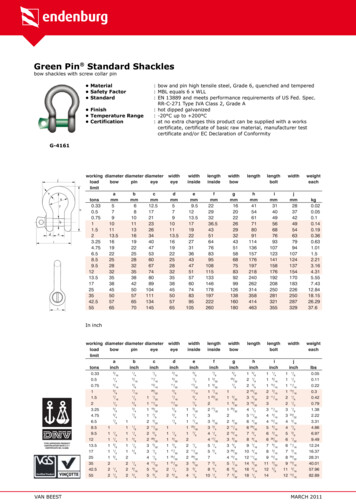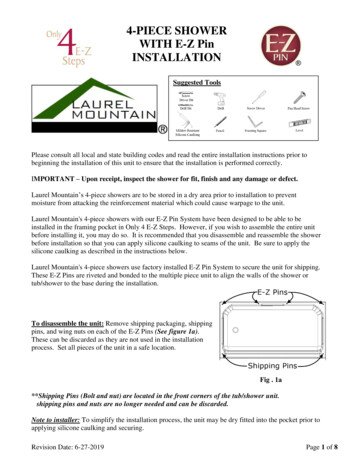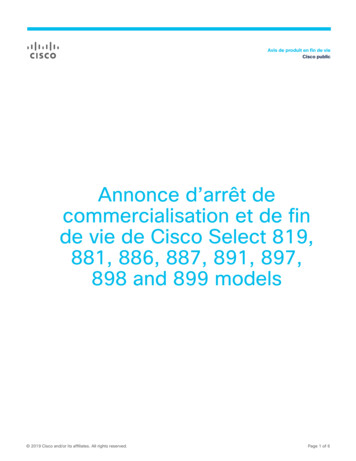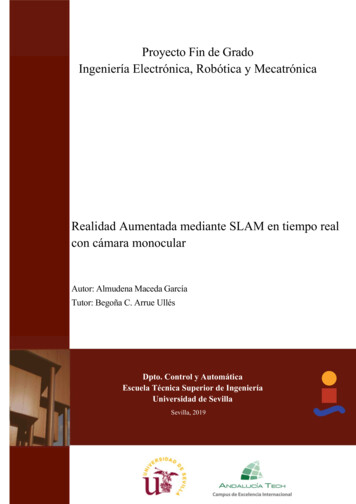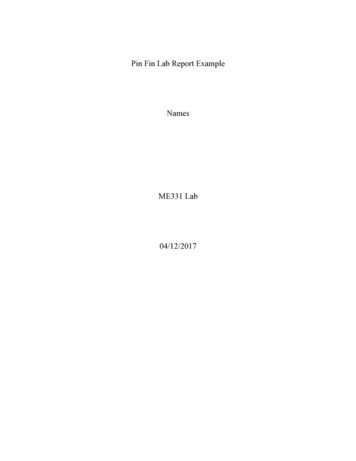
Transcription
Pin Fin Lab Report ExampleNamesME331 Lab04/12/2017
1. AbstractThe purposes of this experiment are to determine pin fin effectiveness and convective heat transfercoefficients for free and forced convection over pin fins of differing length and material. The results frompin fins made of copper, aluminum, and stainless steel showed differing temperature distributions, heattransfer coefficients, and fin effectiveness values. One of the pin fins, made of stainless steel, can betreated as an “infinitely long fin.”2. Introduction / TheoryEmpirical correlations from heat transfer allow one to estimate free and forced convective heat transfercoefficients. Because empirical correlations typically cover a wide range of fluids and flow conditions, anestimated convection coefficient can deviate from the real value by 20% or more. More accurate measuresof convective heat transfer coefficients can be determined experimentally by obtaining temperaturedifferences and/or heat transfer rates using a testing prototype.In this experiment, temperature distributions for three different pin fins are measured under natural andforced convection boundary conditions. The three cylindrical-rod pin fins used in these experiments aremade of copper, stainless steel, and aluminum. The rate of heat transfer into each pin fin is determined bythe electrical power of the heater at the base of the fin and by the conduction rate through the base of thefin. The primary purpose of this experiment is to compare heat transfer coefficients obtainedexperimentally with estimated values from (text book) empirical correlations. The secondary purpose isto compare values of pin fin effectiveness for different fin lengths and materials.3. ProcedureThe apparatus consists of three different fins, each with a heater at the base of the fin surrounded byinsulation to reduce heat loss. Five to seven thermocouples are placed along the longitudinaldirection. Temperatures are measured, displayed and recorded with DAQ devices. Two Keithleymeters measure the voltage and current drawn by the heater in order to measure the electrical power.A switch box selects the fin being monitored by the Keithley meters.4. Results4.1. Estimate the fin heat transfer rate qf assuming negligible heat loss from the insulated heater /base.q ! 𝑞!"!# %&#'" 𝑉𝐼Fin typeq ! [W]Stainless Steel6.51Round Copper8.76Aluminum11.35In practice, considerable heat is dissipated through the insulation box, and the fin heat transferrate is estimated more accurately using Fourier’s law:q ! 𝑘𝐴!Natural convection:Fin typeStainless Steel1.06q ! [W]𝑑𝑇𝑑𝑥!!! 𝑘𝐴!𝑇! 𝑇!𝑥!Round Copper3.68Aluminum5.13
Forced convection:Fin typeq ! [W]Stainless Steel1.21Round Copper6.35Aluminum6.48Throughout this example report the heat transfer rates q! are calculated from the secondapproach using Fourier’s law.4.2. Estimate h values using an overall heat balance on the fin and an “average” fin surfacetemperature for both the natural and forced convection cases.Treating the fin as a lumped object with uniform “average” temperature:q ! ℎ𝐴!"# 𝑇! 𝑇!ℎ 𝑞!𝐴!"# (𝑇! 𝑇! )where A!"# 𝜋𝐷𝐿 𝜋𝑟 ! for cylindrical rod fins.An average fin temperature is calculated from simple averaging of all thermocouples along thefin:𝑇! !! !!!! !!!! !!!! !!!! !!!! !!!!!,or 𝑇! !! !!!! !!!! !!!! !!!!!for the copper fin.Calculated values of h are tabulated below:Natural convection:Fin typeStainless Steelh [W/m2K]7.0Copper10.5Aluminum9.6Forced convection:Fin typeh [W/m2K]Copper56.7Aluminum35.9Stainless Steel15.24.3. Predict the temperature profile T(x) along the length of the pin fin, based on an appropriateboundary condition at the fin tip, x L, and the fin heat transfer rate qf.The appropriate boundary condition at the fin tip is the convection heat transfer condition suchthat:dθhθ L k,where θ T T! .dx !!!The temperature distribution is thus:ℎcosh 𝑚 𝐿 𝑥 𝑚𝑘 sinh 𝑚(𝐿 𝑥)θ ℎ𝜃!cosh 𝑚𝐿 𝑚𝑘 sinh 𝑚𝐿
where m ℎ𝑃/𝑘𝐴!All of the known fin material properties are tabulated below:Fin typek [W/mK]Stainless Steel16Copper388Aluminum167Predicted and measured temperatures are calculated and plotted against longitudinal position asshown in Figures 1-4.4.4. How do the predicted T(x) profiles compare with the measured profiles? On the same graph,plot and compare the predicted and measured temperature profiles T(x) along the length of thefin, first for the natural convection case, then for the forced convection case.Predicted temperature profiles generally agree well with measured temperatures except there issignificant deviation in the case of the stainless steel fin. This is due to a large temperaturegradient at the base of the fin resulting in poor estimations of the heat transfer coefficient. Due tothe lower thermal conductivity of stainless steel, there is greater temperature gradient at the baseof this fin; therefore, assignment of a properly weighted "average" surface temperature requiresgreater care. Adjusted values of natural and forced convection coefficients to obtain betteragreement between measured and predicted T(x) are shown in the plots of Figure 4. These valuesof heat transfer coefficient are significantly higher than the initial estimates, indicating that theaverage temperature was overestimated and the heat transfer coefficients were underestimated,based on the simple arithmetic average of the stainless steel pin fin surface temperatures.Furthermore, in the case of the stainless steel pin fin, the effects of radiation heat transfer arenon-negligible.Stainless steel adjusted hh [W/m2K]Natural convection18.3Forced convection76.0
100Natural convection, predictedNatural convection, measuredForced convection, predictedTemperature [ C]80Forced convection, measured60402000.050.10.15Position [m]0.20.250.3Figure 1. Predicted and measured temperature distributions T(x) along the length of the stainlesssteel pin fin.
100Natural convection, predictedNatural convection, measuredFoced convection, predictedTemperature [ C]80Forced convection, measured60402000.050.10.15Position [m]0.20.250.3Figure 2. Predicted and measured temperature distributions T(x) along the length of the copperpin fin.
100Natural convection, predictedNatural convection, measuredForced convection, predictedTemperature [ C]80Forced convection, measured60402000.050.10.15Position [m]0.20.250.3Figure 3. Predicted and measured temperature distributions T(x) along the length of thealuminum pin fin.
100Natural convection, predictedNatural convection, measuredForced convection, predictedTemperature [ C]80Forced convection, measured60402000.050.10.15Position [m]0.20.250.3Figure 4. Predicted and measured temperature distributions T(x) along the length of the stainlesssteel pin fin with adjusted values of natural and forced convection coefficients.
4.5. Obtain another estimate of the heat transfer coefficient by using measured air velocity andan appropriate forced convection correlation from Chapter 7 of your textbook. Using thisestimate of h from an empirical correlation, how does the predicted T(x) compare with measuredvalues?Empirical correlations relate the heat transfer coefficient of a cylinder (pin fin) in cross flow withthe Prandtl number and Rayleigh number for natural convection,!/!0.387𝑅𝑎!Nu {0.6 }![1 (0.559/𝑃𝑟)!/!" ]!/!"or the Prandtl number and Reynolds number for forced convection:!/!0.62 𝑅𝑒! 𝑃𝑟!/!𝑅𝑒! !/! !/!Nu 0.3 [1 () ][1 (0.4/𝑃𝑟)!/! ]!/!282000The Prandtl number is evaluated at the film temperature,T! 𝑇! 𝑇!2and the characteristic dimension for the Reynolds and Rayleigh numbers is the pin fin diameter:Re! Ra! where, for an ideal gas, β 1/T! .𝑉𝐷𝜈𝑔𝛽 𝑇! 𝑇! 𝐷! 𝑔 𝑇! 𝑇! 𝐷! 𝜈𝛼𝜈𝛼𝑇!Convective heat transfer coefficients from empirical correlations are tabulated below:Natural convection:Fin typeStainless Steel27.69ℎ!"# [W/m K]Round Copper8.74Aluminum8.59Forced convection:Fin typeℎ!"# [W/m2K]Round Copper54.2Aluminum48.3Stainless Steel60.0The effects of radiation heat loss are non-negligible, especially for the stainless steel fin with arelatively high emissivity value as shown in the table below. A simplified lumped analysis can beperformed with an average surface temperature to incorporate the effects of radiation heat losswith an effective radiation heat transfer coefficient:
!Emissivity:Fin type!ℎ!"# 𝜀𝜎(𝑇! 𝑇!"#)(𝑇! 𝑇!"# )Stainless Steel0.8Round Copper0.05Aluminum0.1Natural convection:Fin typeStainless Steel25.29ℎ!"# [W/m K]Round Copper0.387Aluminum0.758Forced convection:Fin typeℎ!"# [W/m2K]Round Copper0.326Aluminum0.650𝜀Stainless Steel5.03Based on the radiation coefficients hrad tabulated above for the natural and forced convectioncases, the tables below give the overall effective heat transfer coefficients for convection andradiation combined, in both the natural and forced convection cases for each of the three pin fins:Natural convection:Fin typeStainless Steelheffective [W/m2K]13.0Round Copper9.13Aluminum9.35Forced convection:Fin typeheffective [W/m2K]Round Copper54.5Aluminum48.9Stainless Steel65.04.6. Plot and compare the predicted and measured temperature profiles T(x) along the length ofeach pin fin, making sure to obtain a new estimate of h for each pin fin configuration, based onmeasured air velocity and at least one correlation from Chapter 7.Parts 3 and 4 are repeated with the heat transfer coefficients obtained in part 5. The results areshown in Figures 5, 6 and 7 below. In Figure 5 for the stainless steel pin fin, heat loss due toradiation is included and has a non-negligible effect.
100Natural convection radiaion, predictedNatural convection, measuredForced convection radiaion, predictedTemperature [ C]80Forced convection, measured60402000.050.10.15Position [m]0.20.250.3Figure 5. Predicted and measured temperature distributions T(x) along the length of the stainlesssteel pin fin. Radiation heat loss is considered using effective heat transfer coefficient.
100Natural convection radiaion, predictedNatural convection, measuredForced convection radiaion, predictedTemperature [ C]80Forced convection, measured60402000.050.10.15Position [m]0.20.250.3Figure 6. Predicted and measured temperature distributions T(x) along the length of the roundcopper pin fin. Radiation heat loss is considered using effective heat transfer coefficient.
100Natural convection radiaion, predictedNatural convection, measuredForced convection radiaion, predictedTemperature [ C]80Forced convection, measured60402000.050.10.15Position [m]0.20.250.3Figure 7. Predicted and measured temperature distributions T(x) along the length of thealuminum pin fin. Radiation heat loss is considered using effective heat transfer coefficient.
4.7. Calculate the fin effectiveness for all three pin fins, both natural and forced convection cases.Fin effectiveness is the ratio of the fin heat transfer rate to the heat transfer rate that would existwithout the fin:𝑞!ε! ℎ𝐴! 𝜃!Natural convection:Fin typeStainless Steel34ε!Forced convection:Fin typeε!Stainless Steel25Round Copper50Aluminum64Round Copper39Aluminum415. Discussion (25%)5.1. The accuracy of your estimates of convection coefficients h. What are potential sources oferror?The accuracy of the convection coefficients calculated from an average fin surface temperaturerelies on the accuracy of measured q! , 𝐴! , and average surface temperature. The heat lossthrough the insulation contributes to the error of q! ; 𝐴! is as accurate as the geometrymeasurement of the fin; surface temperature error comes from thermocouple error and averagingerror occurs from the discrete positions of the thermocouples which yields an approximateaverage rather than a true surface temperature average. The assumption of uniform temperaturealso results in less accurate values of h.The accuracy of the convection coefficients calculated from empirical relations relies on themeasured air velocity for forced convection and temperature difference from thermocouples.Again, the assumption of uniform properties (temperature, air velocity, air properties) affects theaccuracy of h. There is also uncertainty from the empirical relation itself.5.2. Discuss the uncertainty of forced convection air velocities. Estimate velocity measurementerror.The air velocity profile as a function of position along the pin fin is plotted in appendix C of thelab manual. The standard deviation of the velocity is approximately 20% of the mean value.While the correlation is not linear against air velocity, similar uncertainty can be expected fromthe results of part 5.5.3. Estimate the heat dissipated from the electric heater through the backing insulation. Howdoes this compare with the fin heat transfer rate?
The heat transfer rate q! can be estimated using the theory of heat transfer from extendedsurfaces:ℎsinh 𝑚𝐿 𝑚𝑘 cosh 𝑚𝐿q! 𝑀ℎcosh 𝑚𝐿 𝑚𝑘 sinh 𝑚𝐿where M ℎ𝑃𝑘𝐴! θ! .Subtracting q! from the measured heater power, we can estimate the heat dissipation from theinsulation.Natural convection:Fin typeStainless Steel5.0q!"# (W)Forced convection:Fin typeq!"# (W)Stainless Steel4.2Round Copper5.1Aluminum6.4Round Copper2.7Aluminum5.4The dissipation rate varies in the same trend of fin base temperature, which is consistent withexpectation.!"Similar analysis can be drawn from q ! 𝑘𝐴! !"Natural convection:Fin typeStainless Steel5.4q!"# (W)Forced convection:Fin typeq!"# (W)Stainless Steel5.3!!! 𝑘𝐴!!! !!!!!:Round Copper5.1Aluminum6.2Round Copper2.4Aluminum4.95.4. What is the effect of neglecting radiation? Are the errors greater or lesser for naturalconvection compared to forced convection cases?Previous analyses assumed convection as the only heat transfer mode; however, radiation heattransfer should also be included, particularly for the stainless steel pin fin. The heat transfercoefficient calculated should be considered as a “combined” heat transfer coefficient includingboth convection and radiation. The fact that the h values calculated from empirical corr
12.04.2017 · Pin Fin Lab Report Example Names ME331 Lab 04/12/2017 . 1. Abstract The purposes of this experiment are to determine pin fin effectiveness and convective heat transfer coefficients for free and forced convection over pin fins of differing length and material. The results from pin fins made of copper, aluminum, and stainless steel showed differing temperature distributions, heat transfer .
